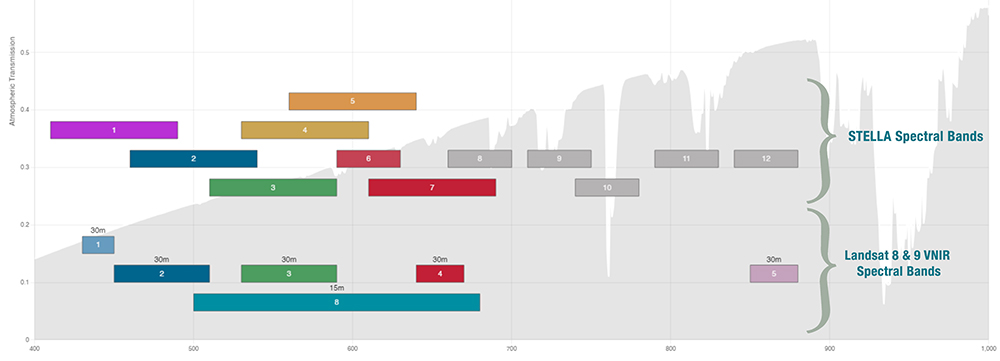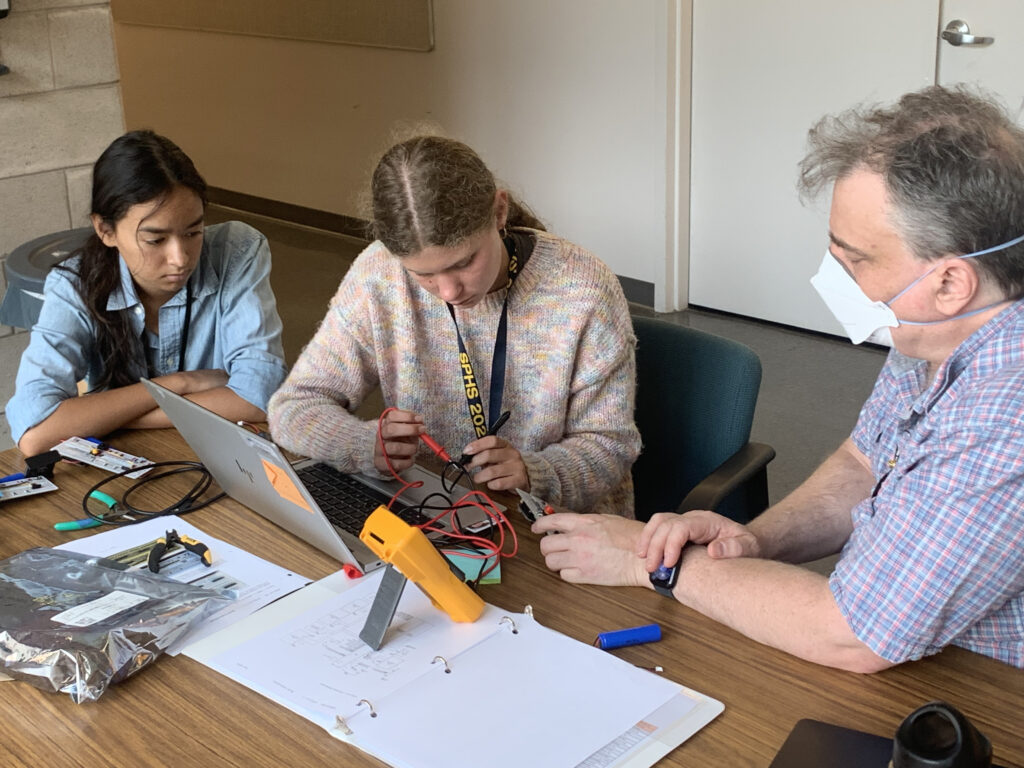By Laura E.P. Rocchio, Landsat Outreach Team

When it comes to land remote sensing, the Landsat satellite program has been a pioneer and steadfast fixture for 50 years. Landsat has helped us recognize and understand patterns of planetary change by collecting images that accurately measure reflected and emitted light from Earth’s surface over the last half-century.
But how does Landsat make these meaningful measurements?
One way to better understand the science and technology behind Landsat’s spectral measurements is to build a spectrometer.
This past summer, two local high school students did just that as part of a NASA STEM Gateway internship with the Landsat Outreach Team at NASA’s Goddard Space Flight Center in Greenbelt, Md.
As rising seniors, Sabrina Pillai and Christina Ballagh spent 10 weeks building DIY hand-held instruments—40 of them to be exact. Called STELLA, for Science and Technology Education for Land/Life Assessment, the spectrometer serves as a low-cost Landsat outreach & education tool.
Once assembled, the STELLA DIY instruments can make 12 different spectral measurements from violet/blue portions of the electromagnetic spectrum out to near infrared regions (beyond our range of vision).

With STELLA in hand, students become citizen scientists making spectral measurements wherever they go.
The STELLA units built by Pillai and Ballagh are now on loan to educational institutions around the country.
STEM Adventures, Starting with Science
Landsat remote sensing is built on science, especially the physics of energy and light. Landsat science also involves the chemical and physical properties of land cover (that determine how light from the sun is reflected and absorbed); the transmission of light through the atmosphere; data calibration; plus, the many, many discipline-specific sciences that make use of Landsat data.
STELLA enables students to understand these aspects of Landsat science using a learn-by-doing approach.
In addition to building and using STELLA instruments, Pillai and Ballagh met with remote sensing scientists and engineers each week selected by Mike Taylor, the Landsat Outreach Team’s STELLA lead and internship mentor

When the STELLA team’s lead scientist, Dr. Petya Campbell, wasn’t in the field, she would meet with the interns to teach them about data collection and analysis. Campbell helped the interns conduct outdoor field testing and an indoor houseplant experiment. Spectral measurements of under watered and properly watered plants were made over the course of the internship to see how the stress impact of drought on plants could be detected spectrally.
The STELLA creator and lead engineer, Paul Mirel met regularly with the interns to answer questions. During one of their first meetings, Mirel and Dr. Manuel Lerdau, a Professor of Environmental Sciences and of Biology at University of Virginia, explained why data collection was an essential aspect of instrument calibration.
Data calibration is what makes Landsat’s data science-quality information. Landsat data help us understand our planet and how it changes from year-to-year. The ongoing ground calibration, comparisons from satellite-to-satellite, and careful attention to sensor accuracy allow for a reliable data set of our planet spanning back decades.
Likewise, each STELLA unit must be calibrated.
STELLA calibration/validation specialist, Jesse Barber, gave the interns a tour of his laboratory and discussed the importance of calibration and how the data collected by Pillai and Ballagh would help calibrate the instruments.

“Seeing the consistency of the STELLAs was satisfying,” Ballagh shared in her internship summary. “I think my favorite part of this internship in general was being able to talk to so many experienced professionals with different fields, degrees, and expertise.”
STELLA’s Origin Story
A number of timely confluences came together to make STELLA in its current form possible—and interns are part of the story.
In 2017, Mirel was working with a NASA heliophysics group called HEAT (Heliophysics Education Activation Team). He came up with an idea to create an educational instrument that could measure visible portions of the spectrum so that students could recreate some early experiments that helped us better understand the light spectrum. Mirel developed an instrument with funding from NASA’s STEAM Innovation Lab.
The Landsat Outreach Team was at the time working with an intern to develop a user- and education-friendly spectrometer. A decade earlier, in 2008, a former Landsat Outreach Specialist, Jeannie Allen, found a hands-on, classroom-friendly spectrometer developed by the Lunar and Planetary Institute, and incorporated it into formal and informal Landsat education projects, allowing users to graph and understand spectral signatures.
Ginger Butcher, the current Landsat Outreach lead, a hands-on learning and makerspace advocate, embraced the use of the tool, but wanted something with a data viewer and expanded spectral capabilities. She brought on intern Lauren Antt to help create a new tool.
Antt connected with Jimmy Acevedo, an intern that had previously worked with Mirel in Observational Cosmology. Together with Butcher, they reached out to Mirel to discuss extending his visible spectrum instrument with near infrared sensors.
Meanwhile, Mirel’s grade school friend and UVA professor, Lerdau, was looking for an educational tool that could measure photosynthetic activity and evapotranspiration to help students understand how sensors could be used to measure and monitor those processes. He asked Mirel if he could help develop such a tool.
With Landsat-funding, Mirel, was able combine the requests of Butcher and Lerdau and develop a low-cost instrument that demonstrates how Landsat satellites work and incorporates visible, near infrared, and thermal measurements.
STELLA was born.
Note: The modular design of STELLA provides the perfect platform to expand capabilities for other science investigations such as incorporating new sensors to measure air quality or adding cuvettes to capture spectral data from liquids.
Technology
STELLA instruments themselves are a prime example of technology—equipment created by applying scientific knowledge.
“Learning how the STELLA is connected between its different sensors and parts… helped increase my knowledge about electronics and sensors and gave me a new perspective about their applications beyond just what is taught in school,” Ballagh shared.

Mirel showed Pillai and Ballagh how the sensors used the clock line to communicate, bringing his oscilloscope and logic level converter to graphically show the varying voltages, and both interns became skillful users of multimeters to measure electrical outputs.
Pillai and Ballagh compared STELLA data to that collected by a professional-grade commercial spectrometer. And they were able to explore the GEDI lidar laboratory, Goddard cleanroom facilities, and Goddard robotics lab.
Engineering

Building 40 STELLAs was a lively introduction to engineering, teaching Pillai and Ballagh about breadboards, electrical components, and signal communication—while strengthening their soldering and troubleshooting skills along the way.
“I came into the internship with a basic understanding of electrical engineering,” Pillai stated in her internship summary, “But now that I actually understand how it works, it has opened my eyes to a whole new field. I can now go home and take a multimeter to fix basic appliances.”
Ballagh designed and developed a sun shield for STELLA after struggling to read the screen in bright daylight. She used AutoCAD and a 3D printer to fabricate the clip-on accessory.
“Making the sun shield was very fun for me,” she shared, “I enjoyed the creative side of it.”
Math
Math is often the language that makes science, engineering, and technology useable and repeatable. Landsat and STELLA science is no different. Pillai and Ballagh used math during their data analysis, converting measurements to radiance then reflectance, plotting data, and using indices to extract meaning from the data they collected. Their full-sun, clear day data plots contributed to a spectral library of spectral signatures and they added some activities to the open data forum.
Interns and Mentors

Pillai and Ballagh were adept interns.
“They conquered everything I threw at them,” Taylor commented.
Taylor’s mentor philosophy was to make sure they used the skills they acquired during the internship, to have them iterate on prototypes of their designs and experiments, and to make sure they saw that failure helps just as much (if not more) than success.
“It was great to hear them ask questions, go through prototypes, and learn how to improve their experiments,” he said. “I also wanted them to have the confidence and understand that they can draw upon the vast resources and people that NASA has to help them with their interests.”
“Their understanding of the need for highly calibrated instruments, vegetation indices, mechanical and electrical engineering, and remote sensing skyrocketed.”
How much did Pillai and Ballagh enjoy their internship experience? As Pillai put it in her parting message to Taylor: “I’ve never had a more amazing experience than this.”
A "Tape Measure" for Light
In this video, Ballagh and Pillai build and use STELLA instruments. Video credit: Sophia Rentschler, intern, NASA Goddard Office of Communications, with Jocelyn Argueta and Sofie Bates, NASA Earth Science Social Media
Further Reading
+ STELLA: NASA’s DIY Educational Gadget for Measuring Plant Health
+ STELLA: A DIY Handheld Scientific Instrument
+ Notes From The Field: Illuminating a Boreal Forest’s Spring Wake-Up, NASA’s Earth Observatory
+ Did you know UAF students are using NASA technology in a hand-held gadget to study the environment? University of Alaska






